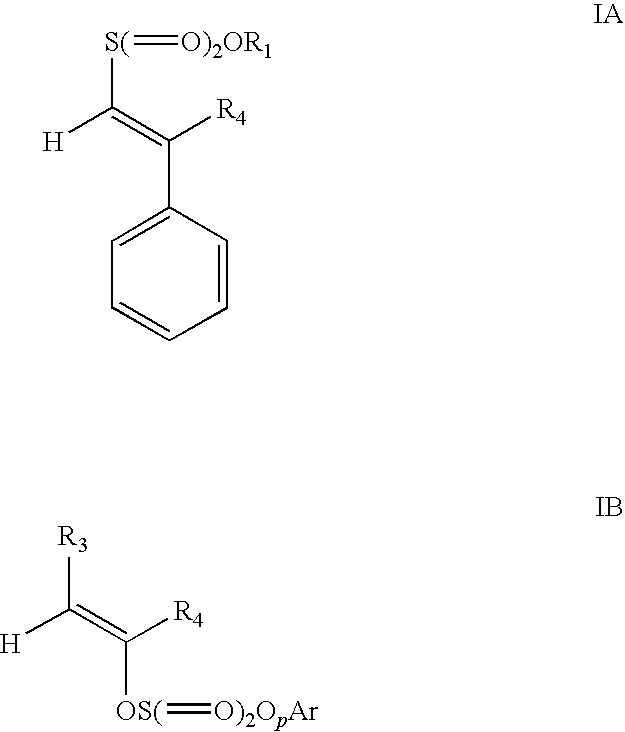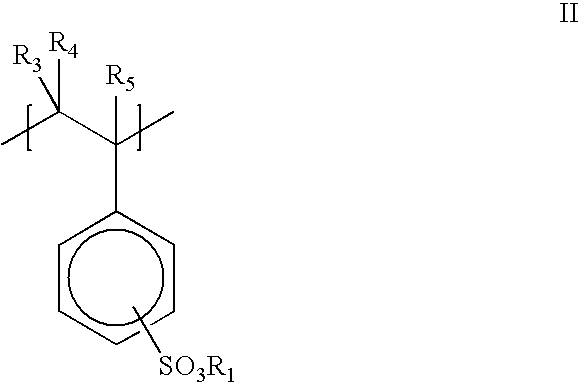Retention and drainage aids
a cellulosic fiber and drainage aid technology, applied in the field of cellulosic fiber compositions, can solve the problems of reducing the efficiency of papermaking, limiting the speed of papermaking, and accumulating deposits, and achieve the effect of reducing the cost of papermaking
- Summary
- Abstract
- Description
- Claims
- Application Information
AI Technical Summary
Benefits of technology
Problems solved by technology
Method used
Image
Examples
example 1
[0052]To a suitable reaction flask equipped with an overhead mechanical stirrer, thermometer, nitrogen sparge tube, and condenser was charged an oil phase of paraffin oil (139.0 g, ESCAID® 110 oil, ExxonMobil—Houston, Tex.) and surfactants (3.75 g CIRRASOL® G-1086 and 11.25 g SPAN® 80, both from Uniqema—New Castle, Del.).
[0053]An aqueous phase was prepared separately which comprised 50 wt % acrylamide solution in water (51.1 g, 50 molar % based on total monomer), styrene sulfonic acid, sodium salt powder (74.44 g, 50 molar % based on total monomer), deionized water (218.47 g), and VERSENEX® 80 (Dow Chemical, Midland, Mich.) chelant solution (0.27 g). The aqueous phase was warmed to about 35-45° C. to dissolve the monomers. The pH of the aqueous solution ranges from 9-11.
[0054]The aqueous phase was then charged to the oil phase while simultaneously mixing with a homogenizer to obtain a stable water-in-oil emulsion. This emulsion is then mixed with a 4-blade glass stirrer while being ...
examples 2-7
[0057]The preparation of polymer was conducted according to the method of Example 1, except for changes provided in Table 1.
[0058]
TABLE 1ExampleMolar CompositionMw, g / mole (106)150% NaSS / 50% AM10230% NaSS / 70% AM8.7350% NaSS / 50% AM25.9470% NaSS / 30% AM10570% NaSS / 30% AM11.86100% NaSS7.07100% NaSS5.4
[0059]The weight average molecular weight MW was determined by batch multi-angle laser light scattering (MALLS) using a Dawn DSP Laser Photometer Optilab DSP Interferometric Refractometer system (Wyatt Technology, Santa Barbara, Calif.). In MALLS batch mode, several concentrations of polymer solution in 1 M NaNO3 were analyzed in order to extrapolate light scattering and refractive index data to very low scattering angles and concentrations. Zimm plots were then constructed, utilizing the light scattering data from several polymer concentrations and detection angles, to obtain the weight average molecular weight MW.
[0060]The method for determining the absolute weight average molecular weigh...
PUM
| Property | Measurement | Unit |
|---|---|---|
| temperature | aaaaa | aaaaa |
| molar ratio | aaaaa | aaaaa |
| speeds | aaaaa | aaaaa |
Abstract
Description
Claims
Application Information
 Login to View More
Login to View More - R&D
- Intellectual Property
- Life Sciences
- Materials
- Tech Scout
- Unparalleled Data Quality
- Higher Quality Content
- 60% Fewer Hallucinations
Browse by: Latest US Patents, China's latest patents, Technical Efficacy Thesaurus, Application Domain, Technology Topic, Popular Technical Reports.
© 2025 PatSnap. All rights reserved.Legal|Privacy policy|Modern Slavery Act Transparency Statement|Sitemap|About US| Contact US: help@patsnap.com



